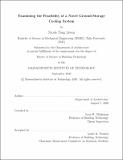Examining the feasibility of a novel ground-storage cooling system
Author(s)
Tang Liwen, Nicole.
Download1288614596-MIT.pdf (16.69Mb)
Other Contributors
Massachusetts Institute of Technology. Department of Architecture.
Terms of use
Metadata
Show full item recordAbstract
The Boston climate is known for its long, cold winters but it also suffers from hot, humid summers. The dehumidification needed to maintain occupant comfort in summer is often provided by condensing the excess moisture onto surfaces cooled by cold water. The systems currently used to provide the cold water have limited efficiencies, so alternative systems must be sought in order to achieve reductions in building energy use and to reduce the rate of climate change. This research examines the feasibility of a ground-cooling storage system that stores the abundant Boston winter cold in an underground block of soil to provide dehumidification in summer. In winter, heat exchangers use the cold air to produce cold water, which flows through a set of pipes in the soil block, cooling the soil. In summer, the cooling stored in the soil block is used to provide cold water for the dehumidifier, thus meeting the latent cooling loads of the building. The physical scale of the system required was found to be reasonable, relative to typical building sizes. The soil block, which does not use any valuable program space, was sized as less than 10% of the overall building size and did not require deep excavation. Winter thermal modeling showed that the soil block could be fully charged in a typical winter season. The summer thermal modeling showed that the system can meet the majority of the building cooling loads and is capable of responding to cooling peaks. The system energy use is primarily driven by the use of the heat exchangers for winter charging. The system was estimated to have a coefficient of performance of 71, which is much higher than that of comparable systems used for dehumidification. In conclusion, this feasibility study found that the proposed system shows promising results as an alternative to conventional systems and is worth further investigation.
Description
Thesis: S.M. in Building Technology, Massachusetts Institute of Technology, Department of Architecture, September, September, 2020 Cataloged from the official PDF of thesis. Includes bibliographical references (pages 101-102).
Date issued
2020Department
Massachusetts Institute of Technology. Department of ArchitecturePublisher
Massachusetts Institute of Technology
Keywords
Architecture.